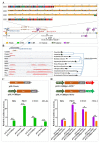SINE Insertion in the Intron of Pig GHR May Decrease Its Expression by Acting as a Repressor
- PMID: 34201672
- PMCID: PMC8300111
- DOI: 10.3390/ani11071871
SINE Insertion in the Intron of Pig GHR May Decrease Its Expression by Acting as a Repressor
Abstract
The genetic diversity of the GH/IGF axis genes and their association with the variation of gene expression and phenotypic traits, principally represented by SNPs, have been extensively reported. Nevertheless, the impact of retrotransposon insertion polymorphisms (RIPs) on the GH/IGF axis gene activity has not been reported. In the present study, bioinformatic prediction and PCR verification were performed to screen RIPs in four GH/IGF axis genes (GH, GHR, IGF1 and IGF1R). In total, five RIPs, including one SINE RIP in intron 3 of IGF1, one L1 RIP in intron 7 of GHR, and three SINE RIPs in intron 1, intron 5 and intron 9 of GHR, were confirmed by PCR, displaying polymorphisms in diverse breeds. Dual luciferase reporter assay revealed that the SINE insertion in intron 1 of GHR significantly repressed the GHR promoter activity in PK15, Hela, C2C12 and 3T3-L1 cells. Furthermore, qPCR results confirmed that this SINE insertion was associated with a decreased expression of GHR in the leg muscle and longissimus dorsi, indicating that it may act as a repressor involved in the regulation of GHR expression. In summary, our data revealed that RIPs contribute to the genetic variation of GH/IGF axis genes, whereby one SINE RIP in the intron 1 of GHR may decrease the expression of GHR by acting as a repressor.
Keywords: GH/IGF axis; GHR; SINE; pig; retrotransposon insertion polymorphism; structural variation.
Conflict of interest statement
The authors declare no conflict of interest.
Figures



Similar articles
-
SINE Insertion May Act as a Repressor to Affect the Expression of Pig LEPROT and Growth Traits.Genes (Basel). 2022 Aug 10;13(8):1422. doi: 10.3390/genes13081422. Genes (Basel). 2022. PMID: 36011333 Free PMC article.
-
Two Retrotransposon Elements in Intron of Porcine BMPR1B Is Associated with Phenotypic Variation.Life (Basel). 2022 Oct 20;12(10):1650. doi: 10.3390/life12101650. Life (Basel). 2022. PMID: 36295085 Free PMC article.
-
Insertion of 643bp Retrotransposon Upstream of PPARγ CDS Is Associated with Backfat of Large White Pigs.Animals (Basel). 2023 Jul 19;13(14):2355. doi: 10.3390/ani13142355. Animals (Basel). 2023. PMID: 37508132 Free PMC article.
-
Somatotropic Axis Regulation Unravels the Differential Effects of Nutritional and Environmental Factors in Growth Performance of Marine Farmed Fishes.Front Endocrinol (Lausanne). 2018 Nov 27;9:687. doi: 10.3389/fendo.2018.00687. eCollection 2018. Front Endocrinol (Lausanne). 2018. PMID: 30538673 Free PMC article. Review.
-
Genetic disorders of GH action pathway.Growth Horm IGF Res. 2018 Feb;38:19-23. doi: 10.1016/j.ghir.2017.12.004. Epub 2017 Dec 12. Growth Horm IGF Res. 2018. PMID: 29249625 Review.
Cited by
-
Taming transposable elements in livestock and poultry: a review of their roles and applications.Genet Sel Evol. 2023 Jul 21;55(1):50. doi: 10.1186/s12711-023-00821-2. Genet Sel Evol. 2023. PMID: 37479995 Free PMC article. Review.
-
Construction of the porcine genome mobile element variations and investigation of its role in population diversity and gene expression.J Anim Sci Biotechnol. 2024 Dec 4;15(1):162. doi: 10.1186/s40104-024-01121-5. J Anim Sci Biotechnol. 2024. PMID: 39627810 Free PMC article.
-
Population structure and genetic diversity of Mi pigs based on SINE-RIPs.Front Vet Sci. 2025 Apr 24;12:1500115. doi: 10.3389/fvets.2025.1500115. eCollection 2025. Front Vet Sci. 2025. PMID: 40343362 Free PMC article.
-
Retrotransposon Insertion Polymorphisms (RIPs) in Pig Coat Color Candidate Genes.Animals (Basel). 2022 Apr 8;12(8):969. doi: 10.3390/ani12080969. Animals (Basel). 2022. PMID: 35454216 Free PMC article.
-
A 280 bp SINE insertion within the pig PLA2G16 could potentially modify gene expression through integration with its transcript.J Appl Genet. 2025 Sep;66(3):689-696. doi: 10.1007/s13353-024-00933-5. Epub 2025 Jan 2. J Appl Genet. 2025. PMID: 39745593
References
-
- Singh D., Sanyal S., Chattopadhyay N. The role of estrogen in bone growth and formation: Changes at puberty. Cell Health Cytoskelet. 2010;3:2–12. doi: 10.2147/CHC.S8916. - DOI
Grants and funding
- 2020M671630/China Postdoctoral Science Foundation
- 31872977/National Natural Science Foundation of China
- 32002146/National Natural Science Foundation of China
- CX (19)2016/Independent Innovation Fund Project of Agricultural Science and Technology in Jiangsu Province
- N/Priority Academic Program Development of Jiangsu Higher Education Institutions
LinkOut - more resources
Full Text Sources
Miscellaneous

